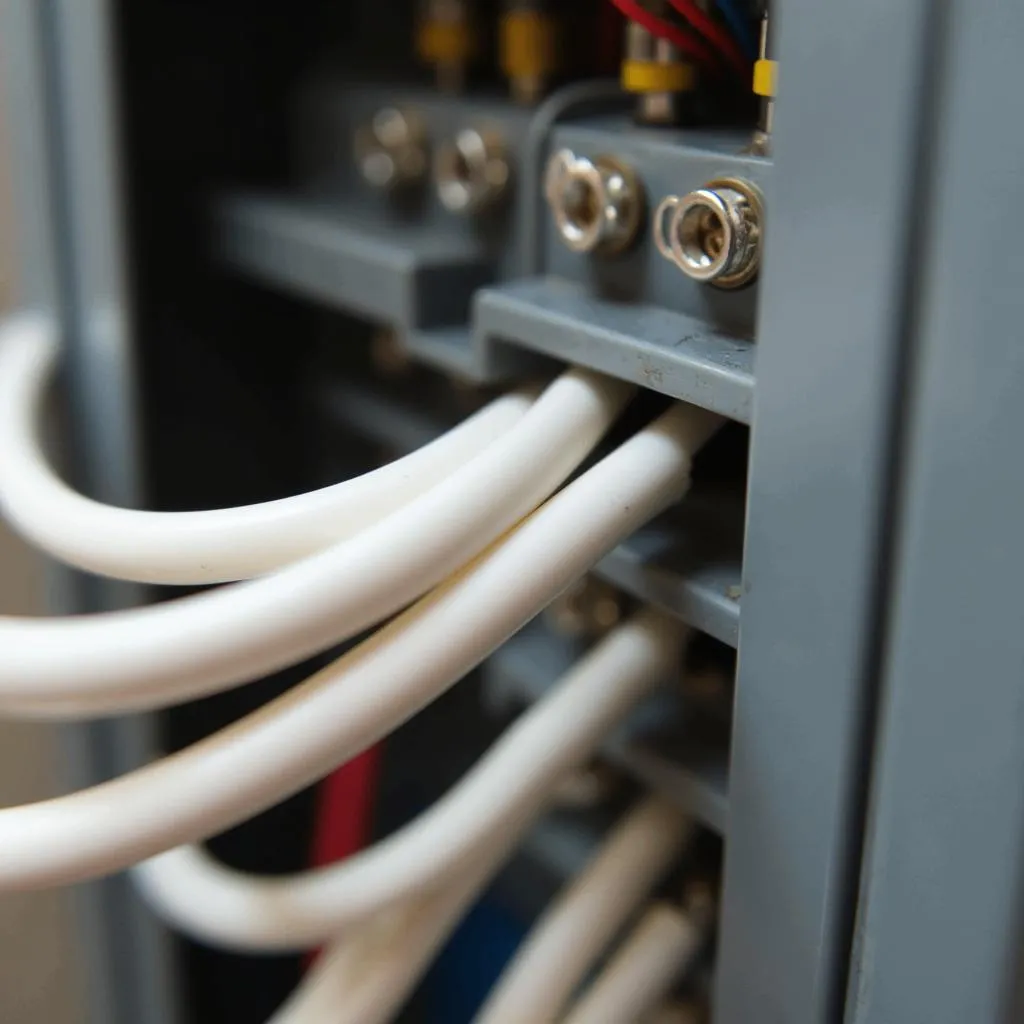Understanding the color coding of electrical wires is crucial for safety and efficiency when working with home wiring. While many people can identify the hot (live) and ground wires, the neutral wire often raises questions. So, what color is a neutral wire in house wiring? This comprehensive guide will delve into the world of electrical wiring, focusing on the neutral wire’s color and its critical role in your home’s electrical system.
Unraveling the Mystery of Neutral Wires
In residential electrical systems, the neutral wire serves as the return path for electrical current, completing the circuit back to the source. It ensures that electricity flows safely and efficiently through your home’s wiring.
 Neutral Wire in Electrical Panel
Neutral Wire in Electrical Panel
Identifying the Neutral Wire: Color Codes
The color of the neutral wire is standardized to ensure universal recognition and prevent electrical mishaps. In most residential wiring systems, the neutral wire is white. This consistent color coding helps electricians and homeowners quickly identify the neutral wire during installations, repairs, or inspections.
Why is the Neutral Wire White?
The choice of white for the neutral wire is not arbitrary. It stems from the grounding system used in most homes. The white color helps distinguish the neutral wire from the grounding wire, which is typically bare copper or green. This clear visual distinction is vital to prevent dangerous wiring errors that could lead to electrical shocks or fires.
Importance of the Neutral Wire
The neutral wire plays a vital role in a safe and functional electrical system. Here’s why:
- Completes the Circuit: It provides the return path for electrical current, allowing electricity to flow back to the source after powering devices.
- Voltage Stabilization: It helps maintain a stable voltage level in the electrical system, preventing voltage fluctuations that can damage appliances.
- Safety: By providing a designated return path, the neutral wire prevents electrical current from flowing through unintended paths, reducing the risk of shocks and fires.
 Neutral Wire Connection to Outlet
Neutral Wire Connection to Outlet
Neutral Wire vs. Ground Wire: Understanding the Difference
While both the neutral and ground wires play crucial roles in electrical safety, they have distinct functions. The neutral wire is the current-carrying conductor that completes the circuit, while the ground wire provides a safe path for stray electrical current to flow to the ground in case of a fault. Confusing these two wires can have serious consequences, so understanding their different roles is essential.
When in Doubt, Consult a Qualified Electrician
Dealing with electrical wiring can be dangerous and should never be taken lightly. If you’re unsure about any aspect of your home’s electrical system, including identifying the neutral wire, it’s always best to consult a qualified electrician. They have the expertise and knowledge to ensure your electrical system is safe and up to code.
Conclusion
Understanding the color coding and function of electrical wires is essential for anyone working with home wiring. Remember, the neutral wire is typically white and serves as the return path for electrical current, completing the circuit and ensuring the safe operation of your electrical system. If you have any doubts or concerns, always consult a qualified electrician for assistance.
FAQs about Neutral Wires
1. Can a neutral wire ever be another color?
While white is the standard color for neutral wires in modern wiring systems, you might encounter older installations with different color codes. For instance, in some older homes, the neutral wire might be black. It’s crucial to consult a qualified electrician if you’re unsure about the wiring in your home.
2. What happens if the neutral wire is not connected?
If the neutral wire is not connected, the circuit will not be complete, and electricity will not flow. In some cases, a disconnected neutral wire can create a dangerous situation where appliances receive an unsafe voltage, potentially leading to damage or even fires.
3. How can I tell if my neutral wire is faulty?
A faulty neutral wire can manifest in several ways, such as flickering lights, dimming lights when appliances turn on, or outlets and devices not working correctly. If you suspect a neutral wire issue, it’s crucial to contact a qualified electrician immediately.
4. Can I use the ground wire as a neutral wire?
No, you should never use the ground wire as a neutral wire. While both wires might seem similar, they have different functions. Using the ground wire as a neutral wire can create a hazardous situation where stray current flows through unintended paths, increasing the risk of electrical shocks and fires.
5. How often should I have my electrical wiring inspected?
It’s generally recommended to have your electrical wiring inspected by a qualified electrician every 3-5 years. More frequent inspections might be necessary if you live in an older home or have recently undergone renovations that involved electrical work.
Need Help with Your Electrical System?
If you have any further questions about neutral wires or need assistance with your home’s electrical system, don’t hesitate to contact us!
Call us: 0373298888
Email us: [email protected]
Visit us: 86 Cầu Giấy, Hà Nội
Our team of experienced electricians is available 24/7 to provide expert advice, reliable services, and peace of mind.
For more information about what color is a neutral wire or what color is home electric neutral wire, please visit our website for detailed articles and resources.

